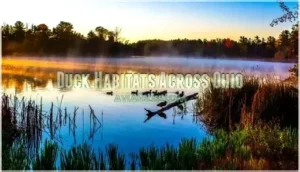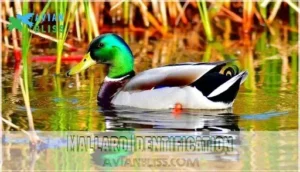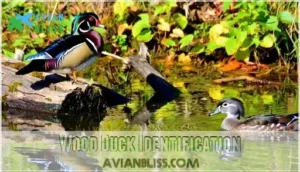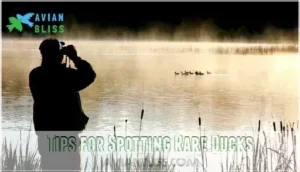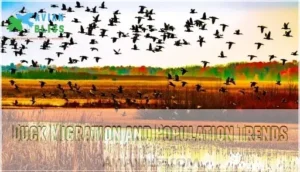This site is supported by our readers. We may earn a commission, at no cost to you, if you purchase through links.
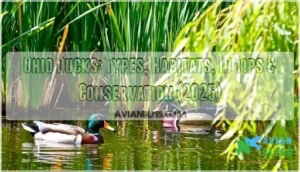
The state shelters millions of birds each year—some call it home, others pass through—a feathered crossroads shaped by water, seasons, and luck. Understanding where these ducks thrive and how to spot them can transform even a routine walk into a story worth sharing.
Table Of Contents
- Key Takeaways
- Types of Ducks Found in Ohio
- Duck Habitats Across Ohio
- Identifying Ohio’s Most Common Ducks
- Duck Migration and Population Trends
- Conservation, Recreation, and Economic Impact
- Frequently Asked Questions (FAQs)
- What is the most common duck in Ohio?
- Does Ohio have ducks?
- What types of ducks are there?
- Are gadwall ducks rare?
- What are the threats to Ohios duck populations?
- Which conservation efforts help Ohios ducks?
- What economic contributions do ducks make in Ohio?
- Are there guided duck-watching tours available?
- How can public awareness support duck conservation?
- What do Ohio ducklings eat in the wild?
- Conclusion
Key Takeaways
- Ohio’s diverse wetlands, rivers, lakes, and even city ponds support a wide range of duck species, each adapted to different habitats and food sources.
- Mallards are the most common duck in Ohio, but visitors can find notable diversity, including dabbling, diving, perching, and occasional rare ducks like Cinnamon Teal and Northern Pintail.
- Habitat loss, climate change, and declining water quality from runoff severely threaten Ohio’s duck populations, making wetland restoration and conservation efforts essential.
- Birdwatching, hunting, and wetland tourism draw millions to Ohio each year, creating significant economic benefits and helping fund ongoing conservation work.
Types of Ducks Found in Ohio
Ohio’s waters host a surprising variety of duck species. Some paddle at the surface while others dive deep for food.
Here’s a breakdown of the main groups you’ll encounter across the state.
Dabbling Ducks (Mallard, American Black Duck, Gadwall)
Dabbling ducks are the shallow-water specialists you’ll spot tipping tail-up in Ohio’s marshes and ponds, feeding on plants and insects without ever fully submerging. These Dabbling Ducks share common habitat preferences but have distinct identification features:
- Mallard — Males flash iridescent green heads and purple-blue speculums; the most common duck in Ohio
- American Black Duck — Year-round resident with dusky plumage and a purple-blue speculum
- Gadwall — Gray-brown body with subtle patterns and white wing patches
- Feeding Habits — All dabble at the surface, consuming aquatic plants and invertebrates
Conservation status remains stable for most species, though breeding behavior and habitat preferences vary by season.
Diving Ducks (Ring-necked Duck, Lesser Scaup, Greater Scaup)
While dabblers stick to the shallows, diving ducks plunge several feet below the surface to hunt fish and aquatic invertebrates in Ohio’s deeper lakes and reservoirs.
You’ll find three key species in these Ohio duck habitats: Ring-necked Duck (medium-sized with a black head), Lesser Scaup (freshwater ponds), and Greater Scaup (larger saltwater bays).
Scaup identification hinges on head shape and habitat preferences, while diving behavior and diet variations reflect their conservation status.
Perching Ducks (Wood Duck)
Unlike their deep-diving cousins, Wood Ducks prefer to perch in trees near quiet woodland streams and wooded swamps, a habit that sets them apart from nearly every other duck in Ohio. You’ll spot them in pairs or solo, showing off striking colors and compact builds.
Their unique adaptations include:
- Tree cavities for duck nesting sites instead of ground nests
- Sharp claws that grip bark during perching
- Specialized diet of acorns and seeds from woodland habitats
Wood Duck ID focuses on iridescent plumage and habitat preferences near forested wetlands.
Mergansers and Sea Ducks
Mergansers slice through Ohio’s waters with serrated bills built for catching fish, while sea ducks brave Lake Erie’s open waves in winter—both groups hunt in ways that would leave a Wood Duck baffled.
You’ll spot Common Mergansers and Hooded Mergansers on rivers and diving sea ducks like Long-tailed Ducks in Lake Erie’s deeper zones during cold months.
Merganser identification focuses on bill shape and diving behavior, while sea duck habitats demand winter adaptations for survival in harsh conditions.
Rare and Uncommon Species (Cinnamon Teal, Northern Pintail)
Beyond the regular crowd, Ohio hosts rare duck species that challenge even experienced birders. The Northern Pintail appears during migration but faces steep decline, while the Cinnamon Teal remains an ultra-rare vagrant with only three confirmed records since 1895.
Habitat loss and climate change effects threaten these species, making conservation priorities critical. You’ll need sharp duck identification skills to spot a Cinnamon Teal’s chestnut plumage at Magee Marsh or recognize a pintail’s elegant silhouette at Killdeer Plains. Cinnamon Teal nests are usually located close to water.
Duck Habitats Across Ohio
Ohio’s ducks rely on a variety of water bodies throughout the state. From sprawling wetlands along Lake Erie to quiet neighborhood ponds, each habitat type nurtures different species and behaviors.
Let’s look at where you’re most likely to find ducks across Ohio.
Wetlands and Marshes (Lake Erie Marsh, Magee Marsh)
Ohio’s wetlands and marshes aren’t just pretty spots on a map—they’re the bustling highway rest stops where thousands of ducks fuel up during their epic north-south journeys. Lake Erie Marsh and Magee Marsh Wildlife Area serve as critical wetland habitat where you’ll witness:
Ohio’s wetlands and marshes are vibrant rest stops where thousands of migrating ducks refuel during their epic journeys
- Diving ducks plunging beneath the surface for aquatic invertebrates
- Dabbling ducks tipping tail-up to reach submerged vegetation
- Perching ducks resting on fallen logs between feeding bouts
Wetland conservation and habitat management efforts focus on water quality improvements and invasive species control to maintain these essential duck habitats and behaviors.
Rivers and Lakes
From the sluggish currents of the Muskingum to the wide-open waters of Alum Creek Lake, Ohio’s rivers and lakes give ducks a different kind of home base than wetlands ever could.
River habitats along Ohio watersheds support diving ducks hunting fish and invertebrates in deeper channels. Inland lakes across Ohio provide open-water refuge where scaup and mergansers dive freely.
Water quality in these Ohio lakes and rivers directly shapes which duck species you’ll spot and how long they stick around.
Ponds and Urban Waterways
You mightn’t think much about the retention pond at your office park, but mallards and wood ducks treat these small urban waters like a welcome mat. Suburban duck populations thrive in Ohio’s ponds and urban waterways when clean water and vegetation are present.
- Pond ecosystem health depends on minimal waterway pollution impact from runoff and litter
- Urban duck habitats include retention basins, golf course ponds, and neighborhood lakes across Ohio wetlands and waterways
- Feeding ducks tips: avoid bread—it harms wetland habitat and duck species in Ohio by promoting algae growth
Ohio State Parks and Wildlife Refuges
When over 90% of wetlands disappear, the remaining spots become lifelines. Ohio State Parks like Magee Marsh and Ottawa National Wildlife Refuges now shelter up to 1 million ducks during peak migration in the Western Lake Erie Basin.
Wetland restoration benefits include rehabilitating 10,000+ acres since 2000 through refuge management practices focused on controlled water levels and native vegetation.
Birdwatching in Ohio generates considerable economic impact—Magee Marsh’s birding festival alone brings $40 million locally. Birding’s economic impact contributes greatly to local economies, with birders spending over $107 billion in 2022.
Surveying techniques using aerial counts help track populations, but conservation challenges persist: invasive species and unpredictable climate shifts demand constant adaptation in Ohio wetlands and waterways to maintain wetland preservation for future generations.
Identifying Ohio’s Most Common Ducks
Knowing which duck is which can feel like solving a puzzle at first. Each species has its own set of field marks that make it stand out once you know what to look for.
Let’s break down the key features that’ll help you identify Ohio’s most common ducks with confidence.
Mallard Identification
If you’ve ever seen a duck paddling around Ohio’s lakes and wondered if it was a mallard, chances are you were right. Male plumage stands out with its iridescent green head and white neck ring. Females sport mottled brown feathers for camouflage. During eclipse plumage in summer, males resemble females temporarily.
Watch for dabbling behavior—they tip forward to feed rather than dive. Hybridization risks exist with American black ducks, making duck species identification tricky sometimes.
Wood Duck Identification
Wood ducks look like someone painted them with every color in the box—and if you spot one perched on a log or tucked into a tree cavity, you’ll know exactly why they earned their reputation as North America’s most stunning waterfowl.
Males show iridescent green and purple on their crested heads with white stripes. Females display gray-brown plumage with white eye-rings. Their squealing call helps with duck species identification in wetlands.
American Black Duck Identification
American Black Ducks mightn’t win any beauty contests next to their flashy Wood Duck cousins, but their understated charcoal-brown plumage and purple-blue wing patches make them one of the easiest ducks to identify once you know what to look for.
You’ll notice their dark body contrasts sharply with a lighter head. That purple-blue speculum is your key distinguishing feature during flight.
Hybridization concerns with mallards complicate species identification since female plumage can look similar in both species.
Ring-necked Duck and Scaup Differences
Separating Ring-necked Ducks from scaups at a distance can stump even experienced birders since all three species share similar black-and-gray color patterns and prefer the same freshwater habitats. Look for these key Duck Identification Tips:
- Bill Morphology – Ring-necked Ducks have white rings on their bills while scaups show solid gray bills
- Duck Plumage – Ring-necked Ducks display angular head shapes versus the rounded heads of Lesser Scaup
- Plumage Comparison – Greater Scaup shows more white in the wings during flight than other Diving ducks
- Habitat Overlap – All three frequent Ohio’s freshwater ponds but scaups often mix with larger flocks
Tips for Spotting Rare Ducks
Beyond identifying common Ohio Ducks, spotting Rare Duck Sightings like Cinnamon Teal or Northern Pintail requires sharper Birdwatching techniques. Use binocular techniques to scan distant flocks for unusual shapes or plumage variations. Field guide usage helps confirm subtle markings that separate rare Duck Species from their common cousins.
Stealth approaches work best at dawn when ducks are active. Listen for vocalization cues since rare species often produce distinct calls. Seasonal variations matter too—spring and fall migrations bring uncommon visitors to Ohio’s wetlands, so timing your visits increases your chances of rare Duck Identification Tips paying off.
Duck Migration and Population Trends
Ohio’s ducks follow predictable patterns each year as they move between breeding grounds and wintering areas. Understanding these migration cycles helps you know when and where to find different species.
Recent population data shows how duck numbers are shifting due to environmental changes.
Spring and Fall Migration Patterns
Each spring and fall, Ohio becomes a crossroads in the sky as millions of ducks funnel through the state on ancient routes between their northern breeding grounds and southern wintering areas. Peak migration occurs from mid-March through April and September through November.
You’ll spot the highest numbers when cold fronts push migratory birds southward in fall or warming temperatures trigger spring movements. Stopover habitats like Lake Erie’s marshes provide essential rest and feeding areas.
Breeding and Wintering Grounds
While some Ohio ducks breed locally in the state’s marshes and wetlands, others simply pass through on their way to nest in the Canadian prairies or winter along the Gulf Coast. Mallards and wood ducks raise broods in Ohio habitats, while species like northern pintails breed farther north.
Climate effects and habitat loss now challenge both nesting habitats and winter survival for migrating Ohio ducks.
2024 Population Estimates and Trends
During fall 2024, Ohio’s duck population averaged 197,000 ducks statewide during peak migration periods. Annual fluctuations and migration patterns shape duck diversity in Ohio each season.
- Mallard abundance reached 41% of all ducks counted, showing an 8% increase from 2023
- Diving ducks like scaup and ring-necked duck made up 15% of late fall counts
- Regional hotspots in Lake Erie marshes hosted over 110,000 ducks in single surveys
Duck population trends and duck conservation efforts continue monitoring Ohio’s ducks throughout migration.
Impacts of Climate and Land Use
Wetland loss and climate change are reshaping where you’ll find Ohio ducks. Habitat loss from agricultural impacts has eliminated 90% of historic wetlands, while warmer winters delay migration and keep ducks farther north.
Habitat fragmentation and declining water quality from nutrient runoff compound these challenges.
Duck conservation and wetland preservation efforts through programs like NAWMP aim to reverse these trends.
Conservation, Recreation, and Economic Impact
Ducks in Ohio sit at the intersection of ecology and economy. Wetlands support populations, while hunting and viewing drive local revenue.
Below are the key ways conservation and recreation shape Ohio’s duck future.
Wetland Conservation Initiatives (DU, NAWMP)
You can’t protect ducks without protecting the places they call home. Ducks Unlimited in Ohio leads wetland conservation efforts through DU partnerships and habitat restoration projects funded by member contributions and NAWMP impact.
The North American Waterfowl Management Plan prioritizes wetland preservation across the state. With 16,814 members supporting conservation funding, volunteer opportunities let you join waterfowl conservation firsthand.
Duck Hunting Regulations and Zones
If you hunt waterfowl in Ohio, knowing your zone and season dates keeps you legal and in the field longer. Duck Hunting Regulations and Zones touch everything from bag limit rules to the must-have license. Here’s what you’ll need:
- Study your Hunting Zone Dates.
- Understand Bag Limit Rules.
- Get your License Requirements sorted.
- Pass the Waterfowl Identification Test.
- Explore Public Hunting Access.
Birdwatching and Wildlife Viewing
Whether you’re pausing between hunts or just out for a quiet walk, watching ducks paddle and preen can turn any patch of water into your personal front-row seat to Ohio’s wild side. Brush up on Duck identification or snap photos—each sighting adds to your Ohio Ducks memory bank.
Here’s a quick glance:
| Viewing Hotspots | Photography Tips |
|---|---|
| Magee Marsh | Early light’s best |
| Killdeer Plains | Stay low, move slow |
| Ottawa NWR | Use long lenses |
| Buckeye Lake | Respect bird space |
| Alum Creek | Log sightings, join projects |
Economic Benefits to Ohio
Every time you spot Ohio Ducks or cast a line near a marsh, you’re part of an economic ripple. Hunting Revenue and Wetland Tourism fuel small towns. Job Creation stretches statewide, thanks to healthy habitats and Waterfowl.
Add in Ecosystem Services and the Tax Impact from this recreation, and you see why Wetland Preservation is big business for all of us.
How to Get Involved in Conservation
Get a DU membership or join an Ohio Audubon Society walk—there’s a place for everyone. Local volunteering for wetland restoration keeps boots muddy. Reporting duck sightings fuels citizen science.
Attend DU events in Ohio, where conservation efforts take shape. Support habitat protection and wetland preservation—big or small, every action stacks up for ducks and people alike.
Frequently Asked Questions (FAQs)
What is the most common duck in Ohio?
Imagine looking out over a pond—spot a Mallard yet? Their dominance isn’t by accident. Habitat influence, population factors, and seasonal variations all play a part.
If you’re wondering about future projections, Mallards top the list among common duck species.
Does Ohio have ducks?
Ducks make their home across Ohio’s waterways year-round. Thanks to habitat suitability and creative local distribution, you’ll notice a strong duck presence and surprising species diversity—especially when seasonal abundance peaks along marshes, rivers, and lakes statewide.
What types of ducks are there?
Think disco balls at a barn dance: Duck classification covers dabbling ducks, diving ducks, sea ducks, and even occasional hybridization events.
You’ll find surprising plumage variations, unique duck behavior, and fascinating evolutionary origins among North America’s dazzling duck species.
Are gadwall ducks rare?
Gadwall aren’t truly rare, but you mightn’t spot them as often since their habitat needs lean toward shallow wetlands.
Gadwall migration patterns, along with seasonal shifts and conservation status, influence their presence among Ohio’s duck species.
What are the threats to Ohios duck populations?
Habitat loss and climate change stand out as top threats to duck populations here. Agricultural runoff and invasive species change wetlands fast. Hunting pressure matters, too.
Wetland preservation and strong conservation efforts remain vital for facing these challenges.
Which conservation efforts help Ohios ducks?
Wetland Restoration, Habitat Protection, and Education Initiatives create broader ecological benefits. Waterfowl Management relies on Membership Impact and volunteer action.
Wetland Preservation and ongoing Conservation Measures for Ducks—like Duck Habitat Restoration—directly enable long-term Waterfowl Habitat Protection.
What economic contributions do ducks make in Ohio?
Ripples from wetlands reach every pocket—Hunting Expenditures and Birdwatching Revenue power local economies, Wetland Tourism flourishes, and Conservation Funding sustains jobs, ecosystems, and waterfowl habitat.
Wetland preservation isn’t just nature’s work; it’s economic sustenance, too.
Are there guided duck-watching tours available?
Many Ohio state locations now offer guided duck-watching tours. Tour availability, tour costs, and seasons vary by site.
Ohio State Guides share local insight and bird ID tips, making these outings popular in spring and fall.
How can public awareness support duck conservation?
Why not let curiosity take the lead? Citizen science, community involvement, and responsible recreation boost duck conservation efforts.
Educational programs spark understanding, while DU membership and volunteer opportunities empower everyone to join the conservation mission and protect critical habitats.
What do Ohio ducklings eat in the wild?
In the wild, ducklings rely on natural food sources like invertebrates and aquatic vegetation. Their duck diet starts heavy on insect consumption, shifting as they grow.
Parental feeding behaviors also guide ducklings toward the best food sources around.
Conclusion
If you listen at dawn, you might hear a chorus faint as a memory, calling Ohio’s ducks to their hidden coves and open water. Each ripple and wingbeat shows how a wild world fits beside our own.
When you recognize a crest, a band of color, or a distant shape on the current, you’re not just counting birds—you’re joining the landscape’s old story. Ohio’s waterfowl will always remind people how small moments in nature carry lasting meaning.
- https://birdwatchingcentral.com/ducks-in-ohio/
- https://ohiodnr.gov/discover-and-learn/animals/birds/wood-duck
- https://huntinglocator.com/blog/duck-hunting-season-ohio/
- https://www.ducks.org/conservation/waterfowl-surveys/2024-duck-numbers
- https://www.divebombindustries.com/blogs/news/buckeye-birds-waterfowl-hunting-in-ohio

